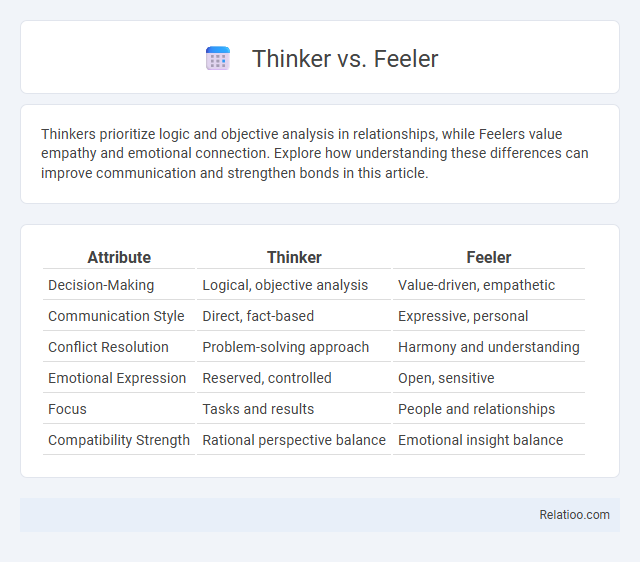Thinkers prioritize logic and objective analysis in relationships, while Feelers value empathy and emotional connection. Explore how understanding these differences can improve communication and strengthen bonds in this article.
Table of Comparison
| Attribute | Thinker | Feeler |
|---|---|---|
| Decision-Making | Logical, objective analysis | Value-driven, empathetic |
| Communication Style | Direct, fact-based | Expressive, personal |
| Conflict Resolution | Problem-solving approach | Harmony and understanding |
| Emotional Expression | Reserved, controlled | Open, sensitive |
| Focus | Tasks and results | People and relationships |
| Compatibility Strength | Rational perspective balance | Emotional insight balance |
Understanding Thinkers and Feelers
Thinkers prioritize logic and objective analysis when making decisions, focusing on fairness and consistency, whereas Feelers emphasize values, emotions, and interpersonal harmony, seeking to accommodate others' needs. Understanding Thinkers involves recognizing their preference for structured problem-solving and detached evaluation, while understanding Feelers requires appreciating their sensitivity and desire for emotional connection. Both cognitive styles influence emotional needs differently, with Thinkers valuing intellectual validation and Feelers requiring empathy and support.
Key Traits of Thinkers
Thinkers prioritize logic, objectivity, and critical analysis when making decisions, relying heavily on facts and rationality rather than emotions. Your decision-making process focuses on fairness and consistency, often valuing truth over personal feelings. Key traits of thinkers include a preference for structured problem-solving, detachment from emotional bias, and a strong emphasis on intellectual clarity.
Key Traits of Feelers
Feelers prioritize harmony, empathy, and understanding in their interactions, often making decisions based on personal values and the emotional impact on others. Your strong emotional need as a Feeler is to feel connected and appreciated, driving a deep sensitivity to others' feelings and a desire for supportive relationships. This emotional intelligence allows Feelers to navigate social dynamics with compassion and foster meaningful bonds.
Cognitive Processes Behind Thinking and Feeling
The cognitive processes behind thinking and feeling involve distinct pathways where thinkers prioritize logical analysis and objective evaluation, while feelers emphasize empathy and subjective experience. Thinkers rely on systematic reasoning and data-driven decision-making to fulfill their cognitive need for coherence and structure. Emotional needs in feelers are rooted in social connection and validation, driving their preference for harmony and relational understanding.
Decision-Making: Logic vs. Emotion
Thinkers prioritize logic and objective analysis in decision-making, relying on facts and systematic evaluation to reach conclusions. Feelers emphasize emotional needs, considering personal values and the impact on others to guide their choices. Understanding this distinction helps balance rational assessment with empathy, improving interpersonal communication and problem-solving effectiveness.
Communication Styles: Analytical vs. Empathetic
Thinkers prefer Analytical communication styles, focusing on logic, facts, and structured arguments, while Feelers prioritize Empathetic communication, emphasizing emotions, values, and personal connections. Understanding Your emotional needs can help balance these styles by recognizing when to present objective data versus showing empathy to foster clearer, more effective interactions. Adapting communication to match both intellectual reasoning and emotional sensitivity enhances collaboration and reduces misunderstandings.
Strengths and Challenges in Relationships
Thinkers excel in problem-solving and logical decision-making, offering clarity and structure to relationships, but may struggle with expressing emotions, leading to misunderstandings with Feelers who prioritize empathy and emotional connection. Feelers bring warmth and compassion, ensuring emotional needs are met, yet may face challenges when logical Thinkers seem detached or overly analytical. Balancing Your inner Thinker and Feeler strengths enhances communication and deepens emotional bonds, addressing diverse emotional needs effectively.
Workplace Dynamics: Thinkers vs. Feelers
In workplace dynamics, thinkers prioritize logic and objective analysis, often making decisions based on data and facts, while feelers emphasize empathy and harmony, considering the impact on team members' emotions. Your ability to balance these approaches enhances collaboration, as recognizing emotional needs alongside rational arguments fosters a more inclusive and effective environment. Effective communication that respects both thinkers' clarity and feelers' values drives better team cohesion and productivity.
Personal Growth for Thinkers and Feelers
Thinkers prioritize logic and objectivity, seeking personal growth through critical analysis and problem-solving skills to enhance decision-making. Feelers focus on empathy and emotional awareness, cultivating personal growth by strengthening interpersonal relationships and emotional intelligence. Addressing emotional needs for both types involves balancing rational thought with emotional understanding to foster holistic development.
Finding Balance: Integrating Thinking and Feeling
Balancing Thinker and Feeler traits involves recognizing the value of both logical analysis and emotional insight in decision-making. Integrating thinking and feeling allows for more nuanced responses to complex situations, enhancing emotional intelligence and problem-solving abilities. Prioritizing this balance meets the emotional needs for understanding and reason, fostering healthier relationships and personal growth.

Infographic: Thinker vs Feeler
 relatioo.com
relatioo.com